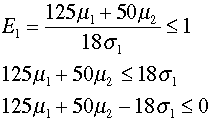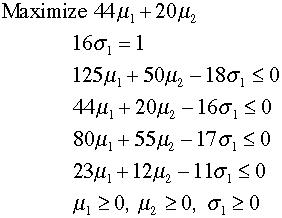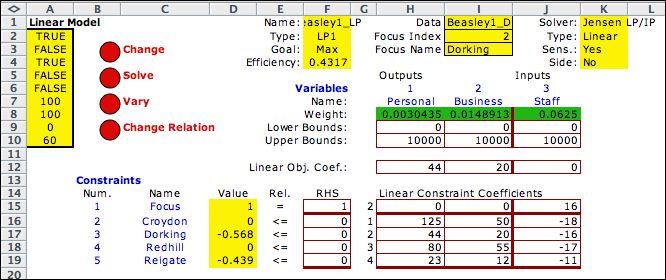Joe, the branch manager
of the Dorking branch does not have it so easy. His branch
has fewer transactions in both categories as Croydon. The branch
does have a smaller staff than Croydon. Perhaps if he gives
a larger weight to staff and less to the transaction outputs,
he will get a better efficiency. Joe had an OR course in college
and knows that OR has methods for optimization. He finds
his old textbook and looks up the term optimization. He learns
that he needs to have an algebraic mathematical model.
His job is to select the weights, so he defines variables
for the output and input factors.

The efficiency for Dorking is the ratio of the
weighted outputs over the weighted input. We index the branches
in the order they appear in the data so Dorking has index 2.

From the formula Joe can see that he can make
the efficiency as large as he wants by increasing the output
weights and decreasing the input weights. He notes however
that the efficiency cannot be greater than 1, so he forms a
constraint on the variables.

Although the ratio limits the variables, they
still are unconstrained from above because as long as the output
weights are proportional to the input weights, the ratio remains
the same. This problem is resolved when Joe sets the weighted
input to 1 and maximizes the weighted output.

After some thought Joe realizes that he can not
make his decision with data regarding only Dorking, He must
assure that the weights assigned do not cause the other
branches to have efficiencies greater than 1 or less than 0.
The lower bound is easy to assure since all inputs and outputs
have positive values. He restricts the weights to nonnegative
values. The efficiencies of the other branches are computed
with similar formulas since all branches must use the same
factor weights. Unfortunately
the ratios are nonlinear and Joe never
studied beyond linear programming (LP). For the LP model all
the expressions must be linear. It happens that the expressions
can be made linear by multiplying both sides of the inequality
by the expression in the denominator. The last step in the
sequence below moves the variable term on the right to the
left side of the inequality. This is the standard form of an
LP constraint.

The complete linear programming model for the
Dorking weight selection problem has three variables and five
constraints.

Using the Math Programming add-in the model can be built on an
Excel worksheet and solved with the Jensen LP/IP Solver. The figure shows the
LP model for Dorking. The LP Solution is shown below in the green field. The
objective value is in cell F4.

Joe is not happy with the results. The maximum efficiency that
Dorking can obtain is 0.4317. The factor weights that solve the LP provide
that efficiency, but no other feasible weights will have a greater efficiency.



